0-30 Vdc Stabilized Power Supply with Current Control 0.002-3 A
- 1.027.428 Views
- medium
- Tested
Copyright of this circuit belongs to smart kit electronics. In this page we will use this circuit to discuss for improvements and we will introduce some changes based on original schematic.
General Description
This is a high quality power supply with a continuously variable stabilised output adjustable at any value between 0 and 30VDC. The circuit also incorporates an electronic output current limiter that effectively controls the output current from a few milliamperes (2 mA) to the maximum output of three amperes that the circuit can deliver. This feature makes this power supply indispensable in the experimenters laboratory as it is possible to limit the current to the typical maximum that a circuit under test may require, and power it up then, without any fear that it may be damaged if something goes wrong. There is also a visual indication that the current limiter is in operation so that you can see at a glance that your circuit is exceeding or not its preset limits.
Technical Specifications
- Input Voltage: ……………. 24 VAC
- Input Current: ……………. 3 A (max)
- Output Voltage: …………. 0-30 V adjustable
- Output Current: …………. 2 mA-3 A adjustable
- Output Voltage Ripple: …. 0.01 % maximum
- PCB dimensions: 123 x 85 mm
Features
- Reduced dimensions, easy construction, simple operation.
- Output voltage easily adjustable.
- Output current limiting with visual indication.
- Complete protection of the supplied device against over loads and malfunction.
How it Works
To start with, there is a step-down mains transformer with a secondary winding rated at 24 V/3 A, which is connected across the input points of the circuit at pins 1 & 2. (the quality of the supplies output will be directly proportional to the quality of the transformer). The AC voltage of the transformers secondary winding is rectified by the bridge formed by the four diodes D1-D4. The DC voltage taken across the output of the bridge is smoothed by the filter formed by the reservoir capacitor C1 and the resistor R1. The circuit incorporates some unique features which make it quite different from other power supplies of its class. Instead of using a variable feedback arrangement to control the output voltage, our circuit uses a constant gain amplifier to provide the reference voltage necessary for its stable operation. The reference voltage is generated at the output of U1.
The circuit operates as follows: The diode D8 is a 5.6 V zener, which here operates at its zero temperature coefficient current. The voltage in the output of U1 gradually increases till the diode D8 is turned on. When this happens the circuit stabilises and the Zener reference voltage (5.6 V) appears across the resistor R5. The current which flows through the non inverting input of the op-amp is negligible, therefore the same current flows through R5 and R6, and as the two resistors have the same value the voltage across the two of them in series will be exactly twice the voltage across each one. Thus the voltage present at the output of the op-amp (pin 6 of U1) is 11.2 V, twice the zeners reference voltage. The integrated circuit U2 has a constant amplification factor of approximately 3 X, according to the formula A=(R11+R12)/R11, and raises the 11.2 V reference voltage to approximately 33 V. The trimmer RV1 and the resistor R10 are used for the adjustment of the output voltages limits so that it can be reduced to 0 V, despite any value tolerances of the other components in the circuit.
Another very important feature of the circuit, is the possibility to preset the maximum output current which can be drawn from the p.s.u., effectively converting it from a constant voltage source to a constant current one. To make this possible the circuit detects the voltage drop across a resistor (R7) which is connected in series with the load. The IC responsible for this function of the circuit is U3. The inverting input of U3 is biased at 0 V via R21. At the same time the non inverting input of the same IC can be adjusted to any voltage by means of P2.
Let us assume that for a given output of several volts, P2 is set so that the input of the IC is kept at 1 V. If the load is increased the output voltage will be kept constant by the voltage amplifier section of the circuit and the presence of R7 in series with the output will have a negligible effect because of its low value and because of its location outside the feedback loop of the voltage control circuit. While the load is kept constant and the output voltage is not changed the circuit is stable. If the load is increased so that the voltage drop across R7 is greater than 1 V, IC3 is forced into action and the circuit is shifted into the constant current mode. The output of U3 is coupled to the non inverting input of U2 by D9. U2 is responsible for the voltage control and as U3 is coupled to its input the latter can effectively override its function. What happens is that the voltage across R7 is monitored and is not allowed to increase above the preset value (1 V in our example) by reducing the output voltage of the circuit.
This is in effect a means of maintaining the output current constant and is so accurate that it is possible to preset the current limit to as low as 2 mA. The capacitor C8 is there to increase the stability of the circuit. Q3 is used to drive the LED whenever the current limiter is activated in order to provide a visual indication of the limiters operation. In order to make it possible for U2 to control the output voltage down to 0 V, it is necessary to provide a negative supply rail and this is done by means of the circuit around C2 & C3. The same negative supply is also used for U3. As U1 is working under fixed conditions it can be run from the unregulated positive supply rail and the earth.
The negative supply rail is produced by a simple voltage pump circuit which is stabilised by means of R3 and D7. In order to avoid uncontrolled situations at shut-down there is a protection circuit built around Q1. As soon as the negative supply rail collapses Q1 removes all drive to the output stage. This in effect brings the output voltage to zero as soon as the AC is removed protecting the circuit and the appliances connected to its output. During normal operation Q1 is kept off by means of R14 but when the negative supply rail collapses the transistor is turned on and brings the output of U2 low. The IC has internal protection and can not be damaged because of this effective short circuiting of its output. It is a great advantage in experimental work to be able to kill the output of a power supply without having to wait for the capacitors to discharge and there is also an added protection because the output of many stabilised power supplies tends to rise instantaneously at switch off with disastrous results.
Construction
First of all let us consider a few basics in building electronic circuits on a printed circuit board. The board is made of a thin insulating material clad with a thin layer of conductive copper that is shaped in such a way as to form the necessary conductors between the various components of the circuit. The use of a properly designed printed circuit board is very desirable as it speeds construction up considerably and reduces the possibility of making errors. To protect the board during storage from oxidation and assure it gets to you in perfect condition the copper is tinned during manufacturing and covered with a special varnish that protects it from getting oxidised and also makes soldering easier.
Soldering the components to the board is the only way to build your circuit and from the way you do it depends greatly your success or failure. This work is not very difficult and if you stick to a few rules you should have no problems. The soldering iron that you use must be light and its power should not exceed the 25 Watts. The tip should be fine and must be kept clean at all times. For this purpose come very handy specially made sponges that are kept wet and from time to time you can wipe the hot tip on them to remove all the residues that tend to accumulate on it.
DO NOT file or sandpaper a dirty or worn out tip. If the tip cannot be cleaned, replace it. There are many different types of solder in the market and you should choose a good quality one that contains the necessary flux in its core, to assure a perfect joint every time.
DO NOT use soldering flux apart from that which is already included in your solder. Too much flux can cause many problems and is one of the main causes of circuit malfunction. If nevertheless you have to use extra flux, as it is the case when you have to tin copper wires, clean it very thoroughly after you finish your work.
In order to solder a component correctly you should do the following:
- Clean the component leads with a small piece of emery paper.
- Bend them at the correct distance from the components body and insert he component in its place on the board.
- You may find sometimes a component with heavier gauge leads than usual, that are too thick to enter in the holes of the p.c. board. In this case use a mini drill to enlarge the holes slightly. Do not make the holes too large as this is going to make soldering difficult afterwards.
- Take the hot iron and place its tip on the component lead while holding the end of the solder wire at the point where the lead emerges from the board. The iron tip must touch the lead slightly above the p.c. board.
- When the solder starts to melt and flow wait till it covers evenly the area around the hole and the flux boils and gets out from underneath the solder.
- The whole operation should not take more than 5 seconds. Remove the iron and allow the solder to cool naturally without blowing on it or moving the component. If everything was done properly the surface of the joint must have a bright metallic finish and its edges should be smoothly ended on the component lead and the board track. If the solder looks dull, cracked, or has the shape of a blob then you have made a dry joint and you should remove the solder (with a pump, or a solder wick) and redo it. Take care not to overheat the tracks as it is very easy to lift them from the board and break them.
- When you are soldering a sensitive component it is good practice to hold the lead from the component side of the board with a pair of long-nose pliers to divert any heat that could possibly damage the component.
- Make sure that you do not use more solder than it is necessary as you are running the risk of short-circuiting adjacent tracks on the board, especially if they are very close together.
- When you finish your work, cut off the excess of the component leads and clean the board thoroughly with a suitable solvent to remove all flux residues that may still remain on it.
Construction (… continued)
As it is recommended start working by identifying the components and separating them in groups. Place first of all the sockets for the ICs and the pins for the external connections and solder them in their places. Continue with the resistors. Remember to mound R7 at a certain distance from the printed circuit board as it tends to become quite hot, especially when the circuit is supplying heavy currents, and this could possibly damage the board. It is also advisable to mount R1 at a certain distance from the surface of the PCB as well. Continue with the capacitors observing the polarity of the electrolytic and finally solder in place the diodes and the transistors taking care not to overheat them and being at the same time very careful to align them correctly.
Mount the power transistor on the heatsink. To do this follow the diagram and remember to use the mica insulator between the transistor body and the heatsink and the special fibber washers to insulate the screws from the heatsink. Remember to place the soldering tag on one of the screws from the side of the transistor body, this is going to be used as the collector lead of the transistor. Use a little amount of Heat Transfer Compound between the transistor and the heatsink to ensure the maximum transfer of heat between them, and tighten the screws as far as they will go.
Attach a piece of insulated wire to each lead taking care to make very good joints as the current that flows in this part of the circuit is quite heavy, especially between the emitter and the collector of the transistor.
It is convenient to know where you are going to place every thing inside the case that is going to accommodate your power supply, in order to calculate the length of the wires to use between the PCB and the potentiometers, the power transistor and for the input and output connections to the circuit. (It does not really matter if the wires are longer but it makes a much neater project if the wires are trimmed at exactly the length necessary).
Connect the potentiometers, the LED and the power transistor and attach two pairs of leads for the input and output connections. Make sure that you follow the circuit diagram very care fully for these connections as there are 15 external connections to the circuit in total and if you make a mistake it may be very difficult to find it afterwards. It is a good idea to use cables of different colours in order to make trouble shooting easier.
The external connections are:
- 1 & 2 AC input, the secondary of the transformer.
- 3 (+) & 4 (-) DC output.
- 5, 10 & 12 to P1.
- 6, 11 & 13 to P2.
- 7 (E), 8 (B), 9 (E) to the power transistor Q4.
- The LED should also be placed on the front panel of the case where it is always visible but the pins where it is connected at are not numbered.
When all the external connections have been finished make a very careful inspection of the board and clean it to remove soldering flux residues. Make sure that there are no bridges that may short circuit adjacent tracks and if everything seems to be all right connect the input of the circuit with the secondary of a suitable mains transformer. Connect a voltmeter across the output of the circuit and the primary of the transformer to the mains.
The voltmeter should measure a voltage between 0 and 30 VDC depending on the setting of P1, and should follow any changes of this setting to indicate that the variable voltage control is working properly. Turning P2 counter-clockwise should turn the LED on, indicating that the current limiter is in operation.
Data
Adjustments
If you want the output of your supply to be adjustable between 0 and 30 V you should adjust RV1 to make sure that when P1 is at its minimum setting the output of the supply is exactly 0 V. As it is not possible to measure very small values with a conventional panel meter it is better to use a digital meter for this adjustment, and to set it at a very low scale to increase its sensitivity.
Warning
While using electrical parts, handle power supply and equipment with great care, following safety standards as described by international specs and regulations.
CAUTION
This circuit works off the mains and there are 220 VAC present in some of its parts.
Voltages above 50 V are DANGEROUS and could even be LETHAL.
In order to avoid accidents that could be fatal to you or members of your family please observe the following rules:
- DO NOT work if you are tired or in a hurry, double check every thing before connecting your circuit to the mains and be ready
- to disconnect it if something looks wrong.
- DO NOT touch any part of the circuit when it is under power.
- DO NOT leave mains leads exposed. All mains leads should be well insulated.
- DO NOT change the fuses with others of higher rating or replace them with wire or aluminium foil.
- DO NOT work with wet hands.
- If you are wearing a chain, necklace or anything that may be hanging and touch an exposed part of the circuit BE CAREFUL.
- ALWAYS use a proper mains lead with the correct plug and earth your circuit properly.
- If the case of your project is made of metal make sure that it is properly earthen.
- If it is possible use a mains transformer with a 1:1 ratio to isolate your circuit from the mains.
- When you are testing a circuit that works off the mains wear shoes with rubber soles, stand on dry non conductive floor and keep one hand in your pocket or behind your back.
- If you take all the above precautions you are reducing the risks you are taking to a minimum and this way you are protecting yourself and those around you.
- A carefully built and well insulated device does not constitute any danger for its user.
If it does not work
Check your work for possible dry joints, bridges across adjacent tracks or soldering flux residues that usually cause problems.
Check again all the external connections to and from the circuit to see if there is a mistake there.
- See that there are no components missing or inserted in the wrong places.
- Make sure that all the polarised components have been soldered the right way round. – Make sure the supply has the correct voltage and is connected the right way round to your circuit.
- Check your project for faulty or damaged components.
Parts List
| Part | Value | Note |
|---|---|---|
| R1 | 2.2 kΩ | 1W |
| R2 | 82 Ω | 1/4W |
| R3 | 220 Ω | 1/4W |
| R4 | 4.7 kΩ | 1/4W |
| R5-R6-R13-R20-R21 | 10 kΩ | 1/4W |
| R7 | 0.47 Ω | 5W |
| R8-R11 | 27 kΩ | 1/4W |
| R9-R19 | 2.2 kΩ | 1/4W |
| R10 | 270 kΩ | 1/4W |
| R12-R18 | 56kΩ | 1/4W |
| R14 | 1.5 kΩ | 1/4W |
| R15-R16 | 1 kΩ | 1/4W |
| R17 | 33 Ω | 1/4W |
| R22 | 3.9 kΩ | 1/4W |
| RV1 | 100 kΩ | trimmer |
| P1-P2 | 10 kΩ | linear pontesiometer |
| C1 | 3300 uF/50V | electrolytic |
| C2-C3 | 47uF/50V | electrolytic |
| C4 | 100nF | polyester |
| C5 | 200nF | polyester |
| C6 | 100pF | ceramic |
| C7 | 10uF/50V | electrolytic |
| C8 | 330pF | ceramic |
| C9 | 100pF | ceramic |
| D1-D2-D3-D4 | 1N5402-3-4 | 2A diode - RAX GI837U |
| D5-D6 | 1N4148 | - |
| D7-D8 | 5.6V | Zener |
| D9-D10 | 1N4148 | - |
| D11 | 1N4001 | diode 1A |
| Q1 | BC548 | NPN transistor or BC547 |
| Q2 | 2N2219 | NPN transistor |
| Q3 | BC557 | PNP transistor or BC327 |
| Q4 | 2N3055 | NPN power transistor |
| U1-U2-U3 | TL081 | operational amplifier |
| D12 | LED diode | - |
Feedback
Another implementation of this power supply is located here – in Czech language
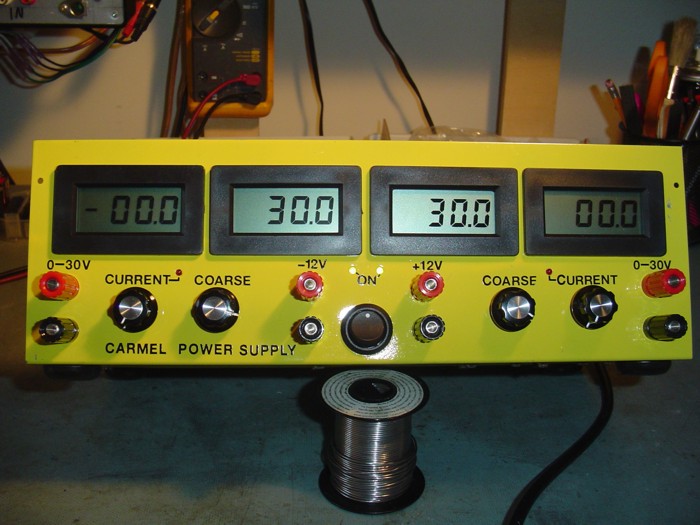
here is a board made by Sam Carmel and worked nice
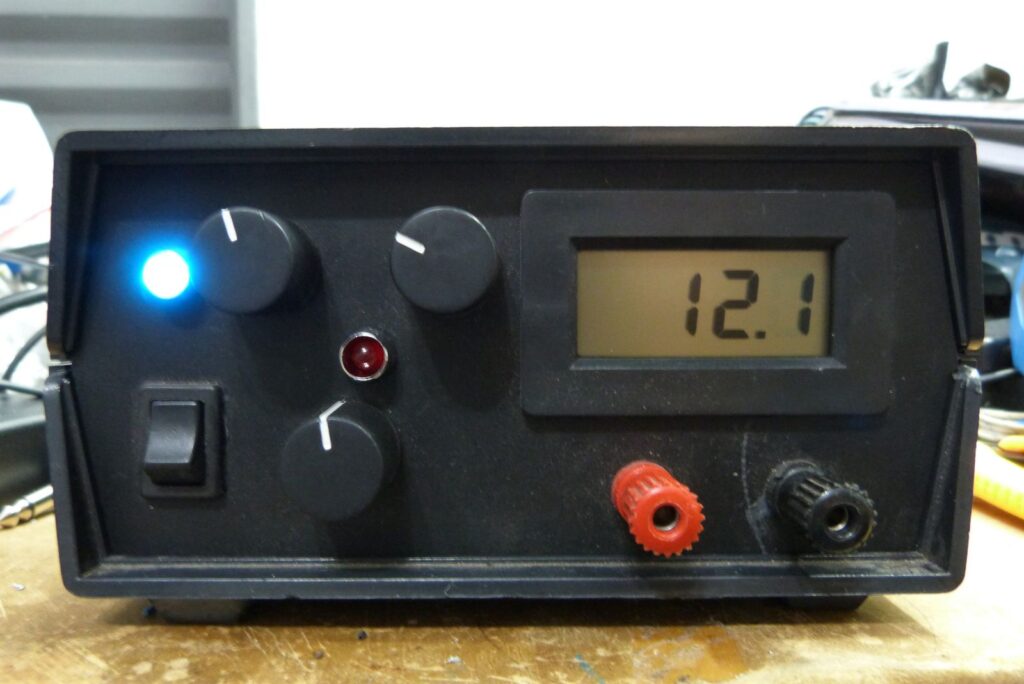
Daniel’s build of PSU – front view with LCD voltmeter
Potensiometers for coarse and fine voltage adjustment and current regulator
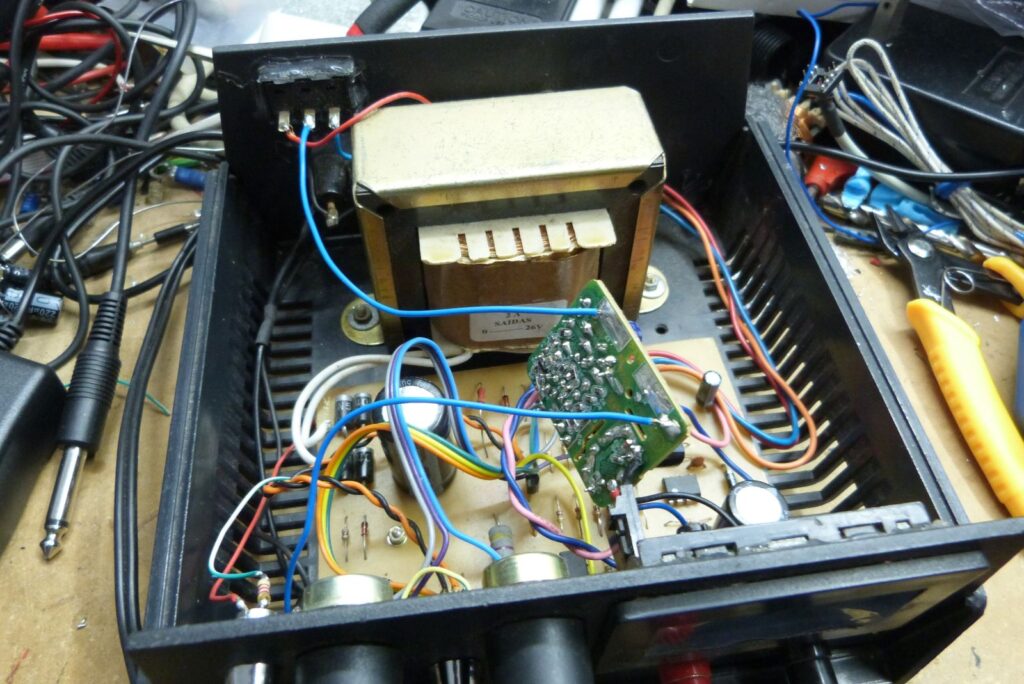
Daniel’s build of PSU – internal view. A mobile phone charger is used as power supply for voltmeter
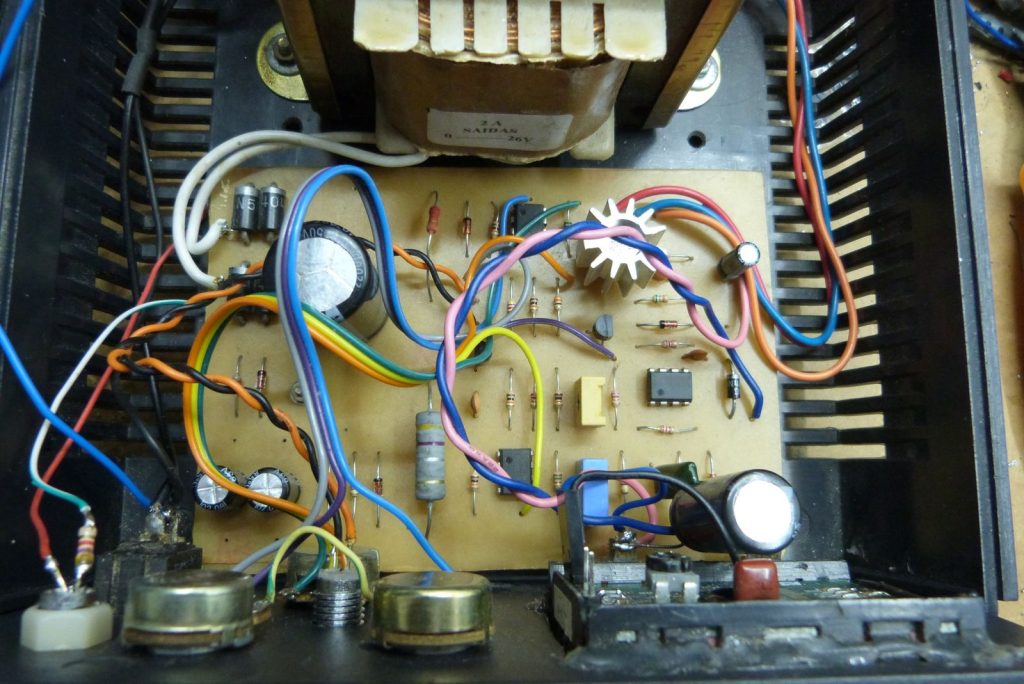
Daniel’s build of PSU – internal view. He is going to change 2200uF a 6800uF capacitor to reduce ripple in high load.
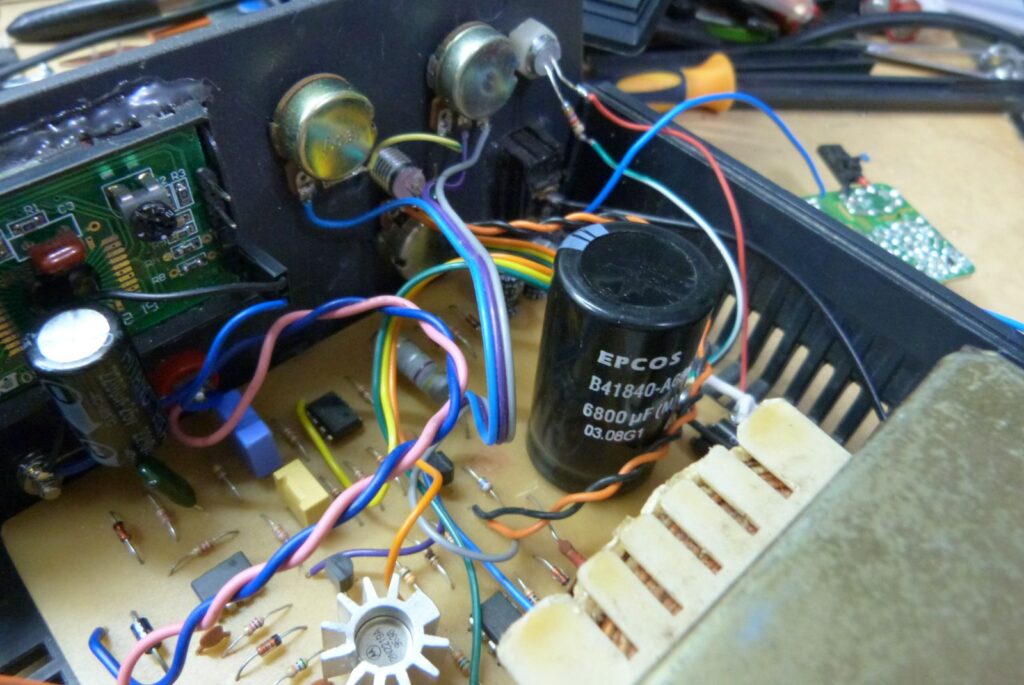
Daniel’s build of PSU – internal view. new capacitor (6800uF x 40V) to improve ripple filtering
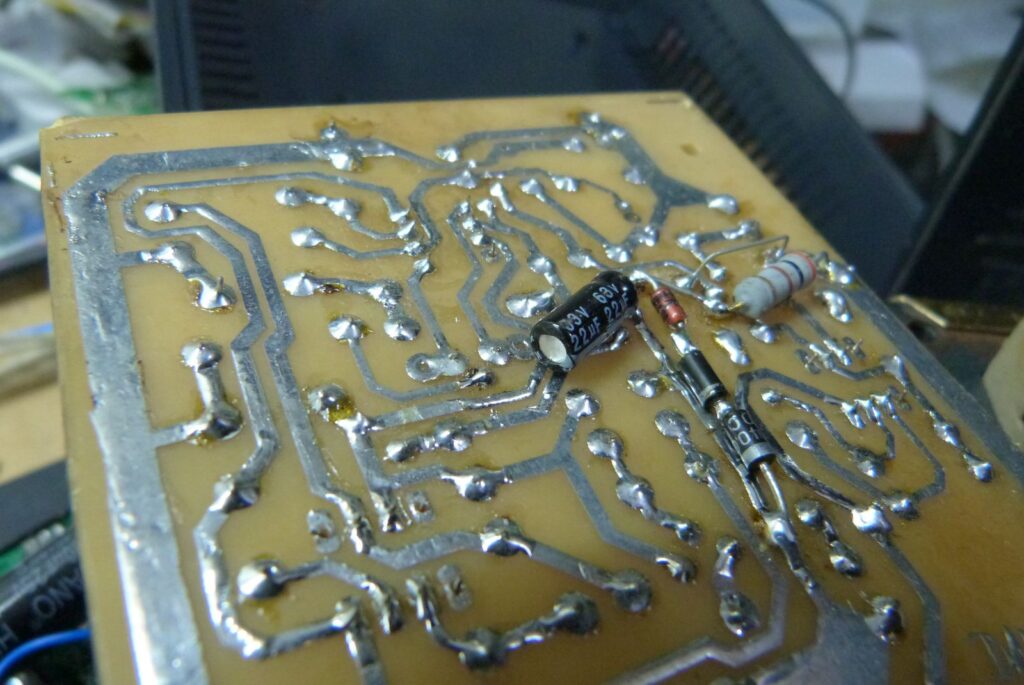
Daniel’s build of PSU – internal view. Modification to protect the LM311
Received the following email from Daniel on 06/2012:
I only face a problem with one of the biggest plagues in electronics now… Fake components. I bougth a fake 2N2219 and it last 100ms (or less) in my first try. As the piece was new I never suspected on it. I spent 2 hours looking for the problem and I could not believe when I test it… I had more two I bougth togeter, they had the same destiny… For my lucky I had a box with old components (some dates from the 70´s) and there I found a genuine Motorola 2N2219… This is running perfect. This was the only difficulty I found…
Received the following email from Ivan on 02/2010:
Ok. I bulid your project about a day ago. Mounted all the parts on the pcb and then concluded that there is some serious problems in this schematics. First, 2N3055 will overheat, so you have to connect two of them in parallel with emitter resistors 0.1ohm/5w. Second, maximal voltage between ‘+’ and ‘-‘ of TL081 is 36VDC.If you connect them as it is shown in this circuit diagram that voltage will be about 45VDC, so they will burn down immediately. To fix this problem you have to reconnect all pins number 7 of U1, U2 and U3, emitter of Q3 and ‘upper’ end of R19 to out of an 7809 with 18V zener diode between ‘common’ pin and ‘-‘ of 3300uF cap, and input of 7809 connect to ‘+’ of the same cap. Now, on pin number 7 and mentioned parts you’ll have 27VDC, and total voltage will be 32.6VDC. Third, instead of using 3300uF, use 4700 or 6800uF/63VDC to reduce the ripple on higher currents (2-3A). The rest of the circuit is perfect. I like it cause it is so inexpensive and easy to make with those simple reconstructions i mentioned.



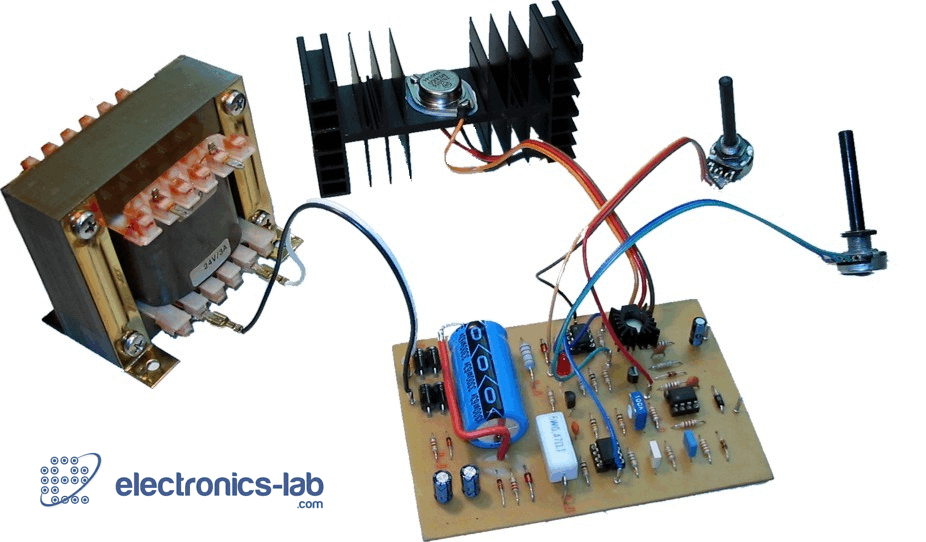
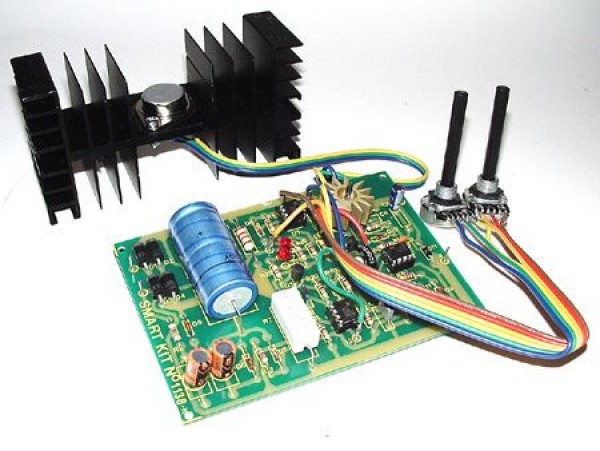
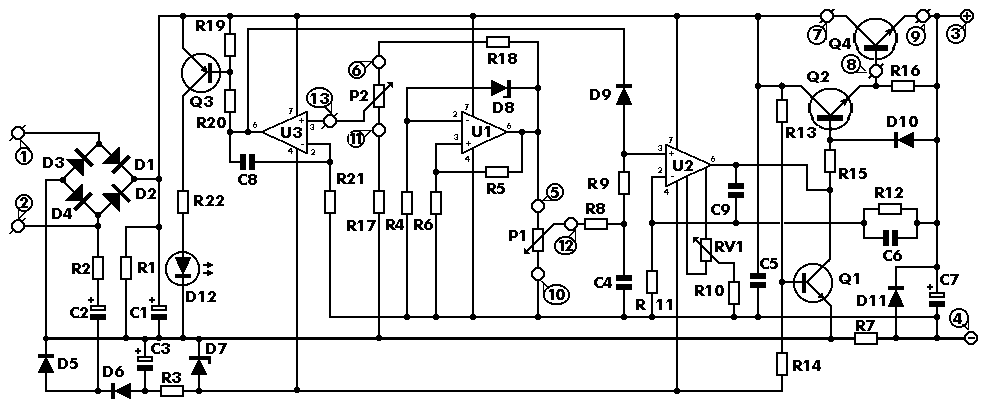

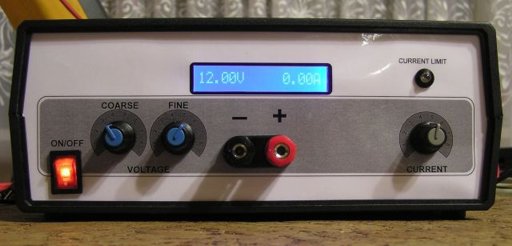
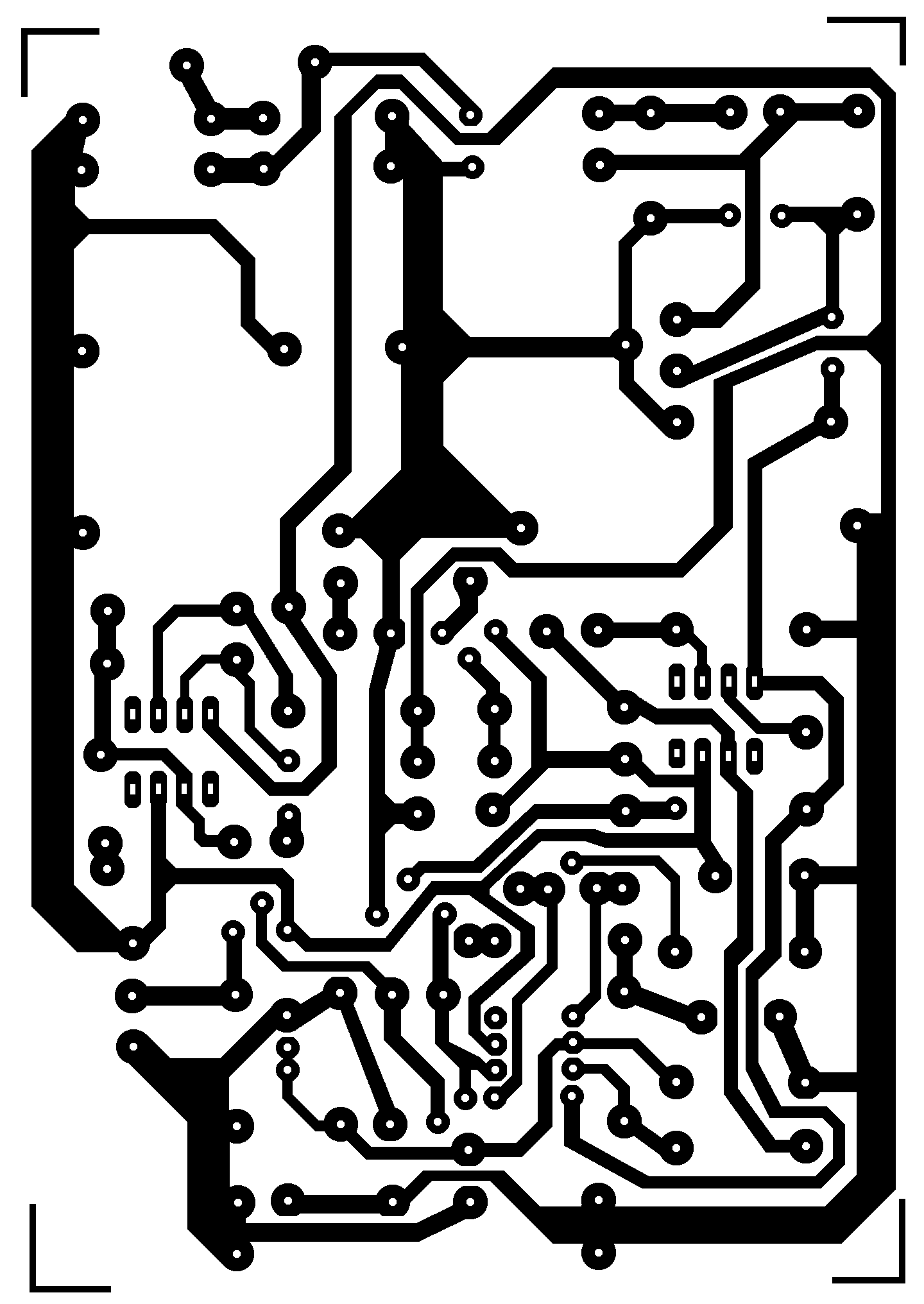
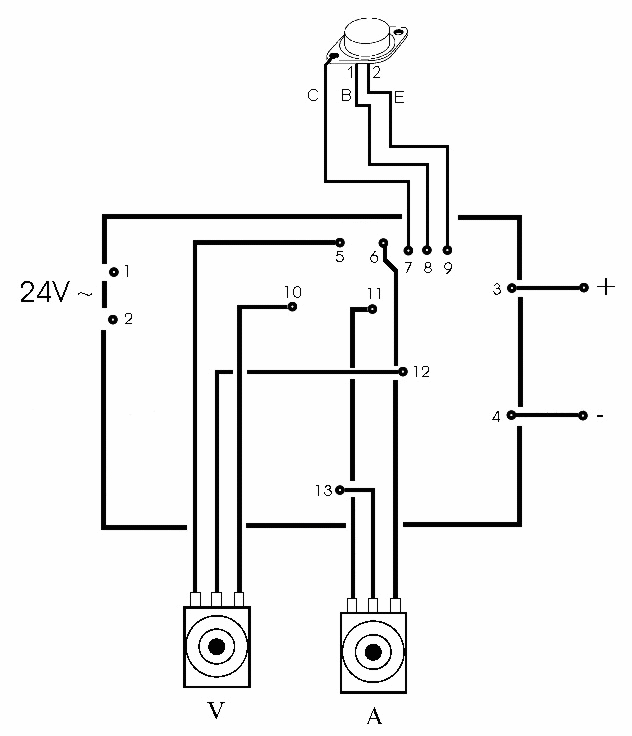
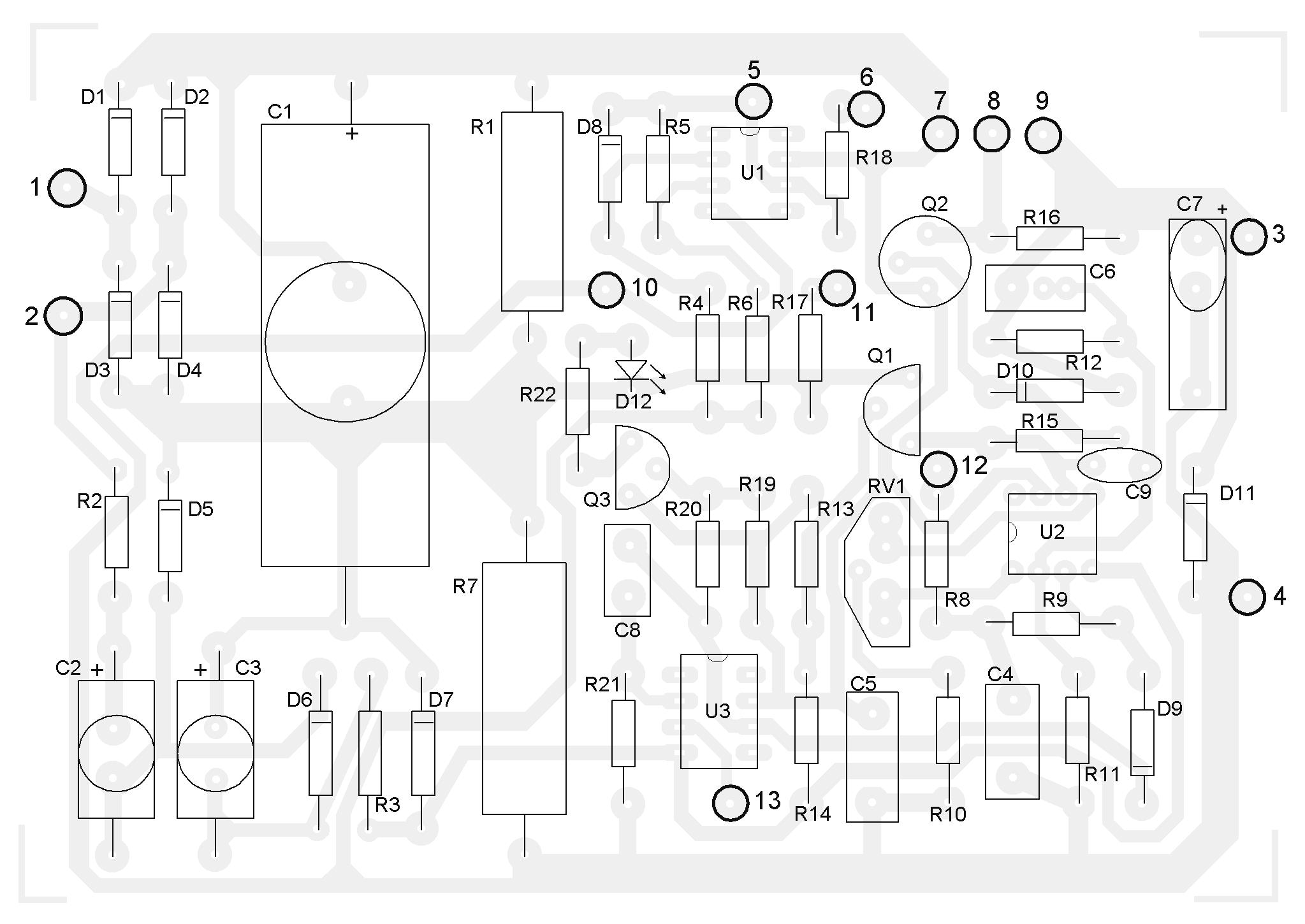


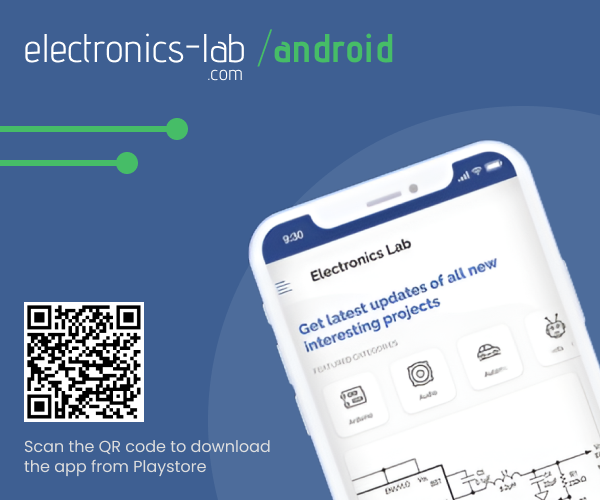


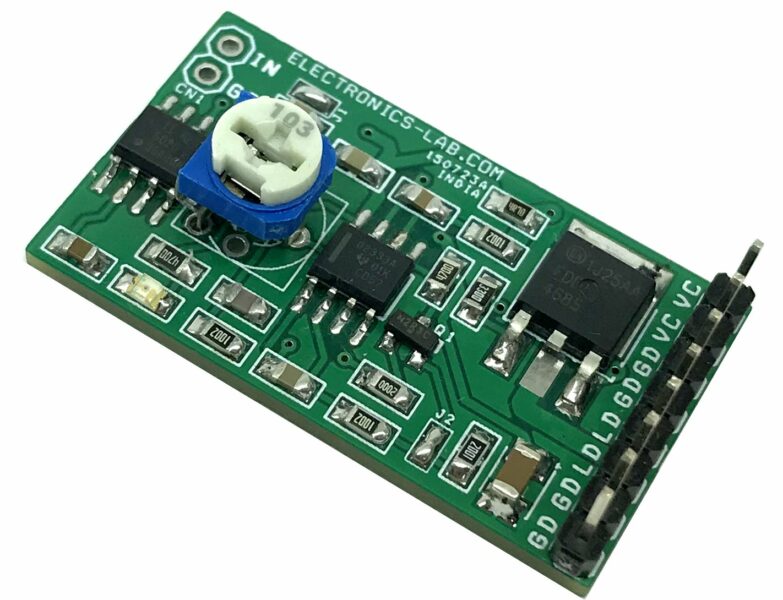


Is there any problem if I use 6800uF & 50V capacitor as C1?
C1 is a filtering capacitor, so a bigger value will do the job also.
Yes, just the voltage needs to be bigger than the [secondary voltage of transformer]*1,41
The last answer put yes when the should have put no. Yes you can use a 6800uF 50V it will work fine.
That’s right, thank you for the correction!
Hi. I have built this power supply in the past. Some years ago I was using this to power up a 6V 15 A dc motor which of course was being limited to #a by the current limiter not knowing that it would go wrong. Now every time I turn it on is gives me solid 30V without any kind of regulation. I have been trying to solve this. In the past I changed the T0-3 2N3055 NPN power transistor together with the 3 opamps. The voltage regulation would be solved but as soon as I connect a load (Resistor and LED) the power supplies messes up again back to 30V constant. I was thinking of changed most of the components on the board since I am unable to figure out exactly what is wrong. But before I do so.. does anybody even have a clue of what it might be? Thanks
Edit : When a small load is connected the power supply only messes up if the current limiter is reduced (action done to confirm if the current limit is working).
Do you tried to swap out D9 diode?
I killed this power supply with a relay on it’s output!
I changed Q2 and it started working again.
What can I do to avoid damaging my power supply with relays?
A relay always needs a backwards biased parallel diode.The collapsing magnetic field generates a negative spike, which kills the transistor.Google relay diode to see how exactly should it connected.
And check the D11 for polarity.The role of D11 is protecting Q2, so if you connected it reversed, then it can not protect yout power transistor.
Jan 2017 WARNING! Some of the kits currently being sold on eBay and Amazon have the small diode markings reversed. This naturally causes damage and the circuit will not work. As no circuit is supplied I wondered if this was a redesign but it seems that simply the making are plain wrong! I have trued to explain this to the sellers (who are Chinese) but they are simply not interested. Double and triple check the small diode marking before soldering.
Hi Robert Philpot. Thanks for sharing this. Could you please specify which diodes that might have wrong markings. And is it the marking on the PCB or the actual diodes provided in the kit? A reference to the schematics on this web page would be great.
Thanks in advance.
Kind regards Torgeir
I am in Vietnam and I have 2n2219 so there is no alternative npn
Look out for BD139. Basically any medium-power transistor will do it.
how change ciruit output 3
amp to 5 or 6 amp.
Please could you send me the PCB layout in PDF form because when i printed it it looks ugly.
Hi. I make this power supply and added Ivan’s modifications without connecting two 2N3055 in parallel and everything were working fine (including short circuit protection).
then i decided to add another 2N3055 in parallel but i did’t use 0.1ohm/5w resistor. after i turned it on i wanted to test short circuit. at that moment the LED didn’t turned on and the output voltage was equaled to 35V and it couldn’t get changed with P1.
after i checked some part i saw one of 2N3055 is failed and the other one looks ok. so i disconnected the broken one and when i turned on the power supply, output voltage was 12.5V. after some few tests i found out R20 was broken too, so i changed it. after that, in the moment that i was turning the power supply on or off the LED was flashing for a second. and after few times of turning on and off it stops flashing (i think R20 failed again)
So can anyone help me?!
My problem solve and when i was testing my power supply, i found out that i couldn’t control current. I test another motor and at that moment i saw that current is about 7 amps !!!!!
When i disconnected the motor, voltage bcame 35V and i can’t change it with P1
pls help!
Hi SidRobo, thanks for sharing your experience with this PSU. I would suggest you to post on the community if you would like to receive support on this. This is the best place for discussions. Also there are some open topics about this power supply. Thanks
Man, your PS needs to be fixed. Check Q2 and Q4, I think u just replace it and everything will be good.
Hi guys, I’ve bought a kit for this PSU and assembled it. It works, at least for small currents, I’ve not yet attached proper heatsink to test it fully. But it has a small glitch. When caps are fully discharged, PSU doesn’t start, overload diode is on, output voltage is about -0.5V. If I then briefly disconnect and reconnect power, PSU starts working correctly. I’ve tried to poke around the circuit and check the voltages, it seems the issue is that output voltage of U1 pin 6 is around 0V . Attaching single multimeter probe to each side of D8 zener diode , so it’s not closed circuit, really just a 1m long wire not connected to anything, “fixes” the issue 🙂 Any idea how to implement proper fix ?
If you can measure negative voltage on the output, thats not good.Check the diodes for polarity, especially D10.
I will encourage you to start a conversation on the community. This is the best place to share your experience. https://electronics-lab.com/community/index.php?/topic/40835-0-30v-0-3a-latest-data/
It seems the issue is caused by negative rail oscillations. I know, i should check that at the very beginning, but this is the first circuit I’m troubleshooting. I’ve captured it with a scope and uploaded it at http://imgur.com/a/wOmRt .
It’s some kind of transient issue, because it occurs only when connecting transformer to AC while circuit is connected secondary. If I first connect transformer to AC and only after that PSU to secondary, negative rail is stable.
The voltage of negative rail when oscillating is below zener voltage of D7, so increasing capacity of C2&C3 let’s say by 50% should fix the issue?
You should check that part of the circuit.What is the voltage before the R3 resistor when it’s oscillating? If you built in used capacitors, check them for capacity, they could be worn out.And check the diodes also. Here is the working principle of that part of the circuit, hope it helps: https://www.allaboutcircuits.com/textbook/semiconductors/chpt-3/voltage-multipliers/
And I have a feeling, that the R2 resistor could have an incorrect value, or the capacitor’s esr is too high.Maybe.
Or if you’re out of ideas, you can swap out R14 to a 3.3v zener like on the czech schematic above.
Sir,
Please tell me i don’t found 1N5402 diode can i use 1N54008 instead of 1N54002.
Can i use 3300uf/71V capacitor instead of 3300uf/50.
And i didn’t found 0.47ohms/5w resiatance can i use 1ohm/5w.
Sir pleaae help me and provide guidelines so i can build..
Thanks.
5408 withstand higher reverse voltage and both has same maximum current (answer is yes). 71V (71? are you sure?) is more than 50V, that capacitor withstand higher voltage and it has same capacity. if it is older one, check it first, it may lose capacity over the years (answer is yes).
You can put 2×1 Ohm in parallel and you’ll get 0.5 Ohm resistor (wattage sum up so it will be 0.5 Ohm 10 W – answer is yes).
Sir,
Please tell me cal i replace 1N4001 with 1N4007 diode.
And replace 200nf polyster capacitor with 220nf.
And when i add two resistor 1ohm5w parallel then watt will be 10w yet my circuit work efficiently..
Thank you.
ok i build it and it work but there is a problem for full load max current is 3 a and voltage is 12v . anyway it’s good
Sir,
Please tell me can I replace 1N4001 with 1N4007 diode.
And can I replace 200nf polyster capacitor with 220nf.
And when i add two resistor 1ohm5w in parallel then watt will be 10w then my circuit work efficiently or not..
Thank you..
Yes both are equivalent. You can replace with 4007.
Sir Admin,
please help me why u3 IC so hot and no output voltage ,and where should i connect RV1 ….can I use 220nf instead of 220..
same problem with me did your worked
Can I use 220nf instead of 200nf , and u2 so hot and output not come and LED also not glow please help me…
is this a dual output
?
Can I use 24VA 2A transformer to get 3 amps output or I will get only 2 amps? Please give me a reply
No you can’t. Yo’re only capable of having 2 Amps out of the transformer. If you try full load on this unit with that transformer, either one them will die immediately..
Sir canyouplease tell me how to connect the 16×2 display with it?
The connection of the LCD ammeter-voltmeter is shown in this page: https://www.electronics-lab.com/project/voltmeter-ammeter-lcd-panel/
Sir , can you please gave me a diagram of dual usb 5v 1a and 2a output power bank circuit with 18650 battery charging option.
does this source deliver -30V as well?
No, it’s only for positive voltages.
Great tutorial.Can I use one of the op-amps of LM224 IC in place of TL081 op-amp used in above circuit.
What type of fuse should be used to protect the circuit?
I would propose to use a fuse on the primary coil of the transformer. To specify it’s rating you can use a multimeter to measure the current while the power supply is giving it’s maximum output power. Then choose a fuse with rating above the measured current.
Hello, I’ve built this power supply in about 2010. It works fine, but there is an issue:
-If it is unpowered and you connect the output leads to a power source, the 2N2219 will certainly die. This scenario is not so unlikely: Simply charging a battery and turning off the PSU before removing the charged battery, or a power outage while charging will destroy it.
-Today I repleced the 2N2219 , but it’s probably a fake component… 3 transistors died in just few seconds of functioning. I used an old 2N2204A, it works fine now. Is there any solution to protect it? (except adding a diode on the output witch will make it working from 0.6v and it will not take negative current from capacitive loads… heat dissipation on diode ect…)
Do you have a diode connected in reverse on the output? I mean, the anode to negative and cathode to positive?
I have no diode in reverse on the output, as negative voltage protection. I will add a relay, so when the PSU is not powered the output will be disconnected. This relay will be supply separately from the transformer, with an independent rectifier bridge and very low capacitange. How will it work? When charging battery, in case of a power outage the relay will disconnect the output leads before C1 (2x8100uF in my case) gets discharged. Also, I will change U1, U2, U3 to TLE2142 and put a 28V transformer. TL081 has only 36V maximum supply. 2N2219 will be replaced by 2N2204a (or BD139), 2N3055 will be replaced by 2x2n2055W. R8 and R18 will be modified (increased), R7 from 0.47Ohm to 0.22Ohm. I hope after all this it should be capable of delivering 0-30V 0-5A. And I suppose there will be no more problems, if a power source is connected to the output when the PSU is off.
Can you tell me what is the feedback path of op-amp U2? Is it Q1-R7-D11-R12?
What type of fuse should be used to protect the circuit??
That’s a good idea but I’d still use a diode. No harm in using one right?
can we use digital potentiomter like mcp41010(10kohms) in place of mechanical to make digitally controlled
YES U CAN! But this power supply actually has some bugs. I’d much prefer buying a switched power supply module and use digital potentiometer with those, like LTC3780 module. Very cheap from China on AliExpress/Banggood.
Hello Everyone, I’ve just bought PCB+parts kit from Banggood and I’m starting to build this power supply.
I have 120VA transformer with secondary voltage 21VAC under load (~23VAC with no load).
It’s clear that I cannot achieve 0-30V range but it’s not important for me.
I did some calculation and I believe that I can achieve at least 0-24V range.
Am I right? Any confirmation/advice please?
Regards
OWL
Hi friends. In this circuit diagram , the U1, U2 and U3 connecting pin number is not clear. So anyone please send me a clear diagram .
I can see OP-AMPS pin numbers on schematic above. Please save image as and open it on an image viewer.
I’ve a question. This power supply is short-circuit?? what i mean is, if i link the outputs to ajust current turn P2 until multimeter show the current that i want?
Yes, right. If you short the output then current regulation will take place and will limit the output current to the defined level. You can measure this current using a simple ammeter.